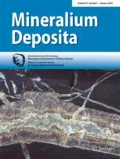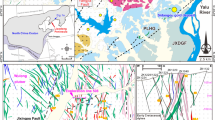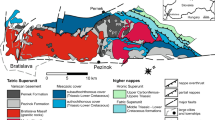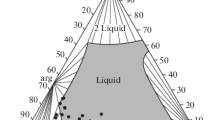Abstract
Several gold deposits display complex Bi-bearing mineralogy. Bismuth-bearing phases are generally sensitive to changes in physicochemical conditions such that the interpretation of Bi–Au associations is useful to understand these mineralizing systems. However, gaps in the physicochemical constraints given by the Bi enrichment in these systems prevent robust metallogenic models in some complex deposits. São Sebastião is a hypozonal gold deposit in the Quadrilátero Ferrífero historic mining district in Brazil, and unlike other Archean gold deposits in this area, it displays a disseminated high-temperature and high-grade sulfide overprint with Bi enrichment. The Bi-bearing mineralogy at São Sebastião is heterogeneously distributed in the BIF-hosted ore bodies. Bismuth-sulfosalts, Bi-chalcogenides, and native bismuth have crystallized in a variable set of intercalated patches, yielding different ore facies given by the fractionation of hydrothermally assisted melts. Base metal–bearing Bi-sulfosalts, electrum, and acanthite result from high-temperature (~ 600 °C) immiscible melts rich in chloride ligands, while late crystallization of high-fineness native gold associated with native bismuth at 271 °C is evidence for Au scavenging by protracted low-temperature Bi-enriched metallic melts. This mechanism has favored gold remobilization from early sulfide assemblages and the development of localized upgraded ore stringers. Rapid uplift from a reduced (low fO2) hypozonal environment to oxidized brittle conditions is suggested by crosscutting bismuthinite-bearing veins’ fluid inclusion patterns and the absence of maldonite (Au–Bi alloy). Many hypozonal deposits like São Sebastião show similar mineralogy and have developed at the boundaries of Archean terrains, registering multiple tectonic overprints where partial melts may have had an essential role in the final ore formation.










Similar content being viewed by others
References
Acosta-Góngora P, Gleson SA, Samson IM, Ootes L, Corriveaus L (2015) Gold refining by bismuth melts in the iron oxide-dominated NICO Au-Co-Bi (± Cu± W) Deposit, NWT, Canada. Econ Geol 110:291–314. https://doi.org/10.2113/econgeo.110.2.291
Aguilar C, Alkmim FF, Lana C, Farina F (2017) Palaeoproterozoic assembly of the São Francisco craton, SE Brazil: new insights from U-Pb titanite and monazite dating. Precambr Res 289:95–115. https://doi.org/10.1016/j.precamres.2016.12.001
Alkmim FF, Marshak S (1998) Transamazonian orogeny in the Southern São Francisco Craton, Minas Gerais, Brazil: evidence for Paleoproterozoic collision and collapse in the Quadrilátero Ferrífero. Precambr Res 90:29–58. https://doi.org/10.1016/S0301-9268(98)00032-1
Baltazar OF, Zucchetti M (2007) Lithofacies associations and structural evolution of the Archean Rio das Velhas greenstone belt, Quadrilátero Ferrífero, Brazil: a review of the regional setting of gold deposits. Ore Geol Rev 32:471–499. https://doi.org/10.1016/j.oregeorev.2005.03.021
Barton PB Jr (1973) Solid solutions in the System Cu-Fe-S. Part I: the Cu-S and Cu-Fe-S Joints. Econ Geol 68:455–465. https://doi.org/10.2113/gsecongeo.68.4.455
Barton PB Jr, Skinner BJ (1979) Sulfide mineral stabilities. Geochemistry of Hydrothermal Ore Deposits, 2nd edn. John Wiley & Sons, New York, pp 278–403
Bodnar RJ (1993) Revised equation and table for determining the freezing point depression of H2O–NaCl solutions. Geochim Cosmochim Acta 57:683–684. https://doi.org/10.1016/0016-7037(93)90378-A
Bouchot V, Ledru P, Lerouge C, Lescuyer J, Milesi J (2005) Late Variscan mineralizing systems related to orogenic processes: the French Massif Central. Ore Geol Rev 27:169–197. https://doi.org/10.1016/j.oregeorev.2005.07.017
Boyle RW (1979) The Geochemistry of Gold and Its Deposits. Canadian Geological Survey Bulletin, 280:584
Brando Soares M, Corrêa Neto AV, Zeh A, Cabral AR, Pereira LF, Prado MGB, Almeida AM, Manduca LG, Silva PHM, Araújo RO, Schlichta TM (2017) Geology of the Pitangui greenstone belt, Minas Gerais, Brazil: stratigraphy, geochronology and BIF geochemistry. Precambr Res 291:17–41. https://doi.org/10.1016/j.precamres.2017.01.008
Brando Soares M, Corrêa Neto AV, Bertolino LC, Alves FEA, Almeida AM, Silva PHM, Araújo RO, Manduca LG, Araújo IMCP (2018) Multistage mineralization at the Hypozonal São Sebastião Gold Deposit, Pitangui Greenstone Belt, Minas Gerais, Brazil. Ore Geol Rev 102:618–638. https://doi.org/10.1016/j.oregeorev.2018.09.028
Brando Soares M, Corrêa Neto AV, Fabricio-Silva W (2020) The development of a Meso- to Neoarchean rifting-convergence-collision-collapse cycle over an ancient thickened protocontinent in the south São Francisco craton, Brazil. Gondwana Res 77:40–66. https://doi.org/10.1016/j.gr.2019.06.017
Buzatu A, Damian G, Dill HG, Buzgar N, Apopei AI (2015) Mineralogy and geochemistry of sulfosalts from Baia Sprie ore deposit (Romania) — new bismuth minerals occurrence. Ore Geol Rev 65:132–147. https://doi.org/10.1016/j.oregeorev.2014.09.016
Cabral AR, Zeh A (2015) Detrital zircon without detritus: a result of 496-Ma-old fluid-rock interaction during the gold-lode formation of Passagem, Minas Gerais, Brazil. Lithos 212–215:415–427. https://doi.org/10.1016/j.lithos.2014.10.011
Cabral AR, Zeh A, Koglin N, Seabra Gomes Jr AA, Viana DJ, Lehmann B (2012) Dating the Itabira iron formation, Quadrilátero Ferrífero of Minas Gerais, Brazil, at 2.65 Ga: depositional U-Pb age of zircon from a metavolcanic layer. Precambrian Research 204–205, 40–45. https://doi.org/10.1016/j.precamres.2012.02.006
Cabral AR, Corrêa Neto AV (2016) Empirical Bi8Te3 and Bi2Te from the São Sebastião gold deposit, Brazil: implications for lode-gold mineralization in Minas Gerais. Can Mineral 53:1061–1072. https://doi.org/10.3749/canmin.1500066
Cabri LJ (1973) New data on phase relations in the Cu-Fe-S system. Econ Geol 68:443–454. https://doi.org/10.2113/gsecongeo.68.4.443
Carneiro MA (1992) O Complexo Metamórfico Bonfim Setentrional (Quadrilátero Ferrífero, MG): Litoestratigrafia e evolução geológica de um segmento de crosta continental do Arqueano PhD thesis. Instituto de Geociências, Universidade de São Paulo. 233
Cave BJ, Barnes SJ, Pitcairn IK, Sack PJ, Kuikka H, Johnson SC, Duran CJ (2019) Multi-stage precipitation and redistribution of gold, and its collection by lead-bismuth and lead immiscible liquids in a reduced-intrusion related gold system (RIRGS); Dublin Gulch, western Canada. Ore Geol Rev 106:28–55. https://doi.org/10.1016/j.oregeorev.2019.01.010
Cepedal A, Fuertes-Fuente M, Martín-Izard A, González-Nistal S, Rodríguez-Pevida L (2006) Tellurides, selenides and Bi-mineral assemblages from the Río Narcea Gold Belt, Asturias, Spain: genetic implications in Cu-Au and Au skarns. Mineral Petrol 87:277–304. https://doi.org/10.1007/s00710-006-0127-7
Cepedal A, Martínez-Abad I, Fuertes-Fuente M, Lima A (2013) The presence of plumboan ingodite and a rare Bi-Pb tellurosulfide, Pb3Bi4Te4S5, in the Limarinho gold deposit, Northern Portugal. Can Mineral 51:643–651. https://doi.org/10.3749/canmin.51.4.643
Chapman RJ, Allan MM, Mortensen JK, Wrighton TM, Grimshaw MR (2018) A new indicator mineral methodology based on a generic Bi-Pb-Te-S mineral inclusion signature in detrital gold from porphyry and low/intermediate sulfidation epithermal environments in Yukon Territory, Canada. Miner Deposita 53:815–834. https://doi.org/10.1007/s00126-017-0782-0
Chemale F Jr, Rosiére CA, Issamu E (1994) The tectonic evolution of the Quadrilátero Ferrífero, Minas Gerais, Brazil. Precambr Res 65:25–54. https://doi.org/10.1016/0301-9268(94)90098-1
Ciobanu CL, Cook NJ, Damian F, Damian G (2006) Gold scavenged by bismuth melts: an example from Alpine shear-remobilizates in the Highiş Massif, Romania. Mineral Petrol 87:351–384. https://doi.org/10.1007/s00710-006-0125-9
Ciobanu CL, Birch WD, Cook NJ, Pring A, Grundler PV (2010) Petrogenetic significance of Au-Bi-Te-S associations: the example of Maldon, Central Victorian gold province, Australia. Lithos 116:1–17. https://doi.org/10.1016/j.lithos.2009.12.004
Cook NJ (1996) Mineralogy of the sulphide deposits at Sulitjelma, northern Norway. Ore Geol Rev 11:303–338. https://doi.org/10.1016/S0169-1368(96)00009-1
Cook NJ (1997) Bismuth and bismuth-antimony sulfosalts from Neogene vein mineralisation, Baia Borsa area, Maramures, Romania. Mineral Mag 61:387–409. https://doi.org/10.1180/minmag.1997.061.406.06
Cook NJ, Ciobanu CL (2004) Bismuth tellurides and sulfosalts from the Larga hydrothermal system, Metaliferi Mts., Romania: paragenesis and genetic significance. Mineral Mag 68:301–321. https://doi.org/10.1180/0026461046820188
Cook NJ, Ciobanu CL, Wagner T, Stanley CJ (2007) Minerals of the system Bi-Te-Se-S related to the tetradymite archetype: review of classification and compositional variation. Can Mineral 45:665–709. https://doi.org/10.2113/gscanmin.45.4.665
Cook NJ, Ciobanu CL, Meria D, Silcock D, Wade B (2013) Arsenopyrite-pyrite association in an orogenic gold ore: tracing mineralization history from textures and trace elements. Econ Geol 108:1273–1283. https://doi.org/10.2113/econgeo.108.6.1273
DNPM (2016) Anuário Mineral Brasileiro – Principais substâncias metálicas. 40p
Dorr VNII (1969) Physiographic, stratigraphic and structural development of the Quadrilátero Ferrífero, Minas Gerais, Brazil. USGS Professional Paper 641-A, 110
Douglas N, Mavrogenes J, Hack A, England R (2000) The liquid bismuth collector model: an alternative gold deposition mechanism. Geological Society of Australia, AGC Abstract volume 59, 135
Duan Z, Møller N, Weare JH (1992a) An equation of state for the CH4–CO2–H2O system: I. Pure systems from 0 to 1000 °C and 0 to 8000 bar. Geochim Cosmochim Acta 56:2605–2617
Duan Z, Møller N, Weare JH (1992b) An equation of state for the CH4–CO2–H2O system: II. Mixtures from 50 to 1000 °C and 0 to 1000 bar. Geochim Cosmochim Acta 56:2619–2631. https://doi.org/10.1016/0016-7037(92)90348-M
Fabricio-Silva W, Rosière CA, Bühn B (2018) The shear zone-related gold mineralization at the Turmalina deposit, Quadrilátero Ferrífero, Brazil: structural evolution and the two stages of mineralization. Miner Deposita 54:347–368. https://doi.org/10.1007/s00126-018-0811-7
Fougerouse D, Micklethwaite S, Tomkins AG, Mei Y, Kilburn M, Guagliardo P, Fisher LA, Halfpenny A, Gee M, Paterson D, Howard DL (2016) Gold remobilisation and formation of high-grade ore shoots driven by dissolution-reprecipitation replacement and Ni substitution into auriferous arsenopyrite. Geochim Cosmochim Acta 178:143–159. https://doi.org/10.1016/j.gca.2016.01.040
Frost BR, Mavrogenes JA, Tomkins AG (2002) Partial melting of sulfide ore deposits during medium- and high-grade metamorphism. Can Mineral 40:1–18. https://doi.org/10.2113/gscanmin.40.1.1
Frost BR, Swapp SM, Mavrogenes J (2011) Textural evidence for extensive melting of the Broken Hill Orebody. Econ Geol 106:860–882. https://doi.org/10.2113/econgeo.106.5.869
Fuertes-Fuente M, Cepedal A, Lima A, Dória A, dos Ribeiro MA, Guedes A (2016) The Au-bearing vein system of the Limarinho deposit (northern Portugal): genetic constraints from Bi-chalcogenides and Bi-Pb-Ag sulfosalts, fluid inclusions and stable isotopes. Ore Geol Rev 72:213–231. https://doi.org/10.1016/j.oregeorev.2015.07.009
Goldfarb RJ, Groves DI (2015) Orogenic gold: common or evolving fluid and metal sources through time. Lithos 233:2–26. https://doi.org/10.1016/j.lithos.2015.07.011
Groves DI, Santosh M, Deng J, Wang Q, Yang L, Zhang L (2020) A holistic model for the origin of orogenic gold deposits and its implications for exploration. Miner Deposita 55:275–292. https://doi.org/10.1007/s00126-019-00877-5
Guadagnin F, Chemale F Jr, Magalhães AJC, Santana A, Dussin I, Takehara L (2015) Age constraints on crystal-tuff from the Espinhaço Supergroup – insight into the Paleoproterozoic to Mesoproterozoic intracratonic basin cycles of Congo-São Francisco Craton. Gondwana Res 27:363–376. https://doi.org/10.1016/j.gr.2013.10.009
Hastie ECG, Kontak DJ, Lafrance B (2020) Gold remobilization: insights from gold deposits in the Archean Swayze Greenstone Belt, Abitibi Subprovince, Canada. Econ Geol 115:241–277. https://doi.org/10.5382/econgeo.4709
Heyen G, Ramboz C, Dubessy J (1982) Simulation des equilibres de phases dans le systheme CO2-CH4en dessous de 50°C and 100 bar. Application aux inclusions fluides. C R Acad Sci Paris 294:203–206
Jian W, Lehmann B, Mao J, Ye H, Li Z, Zhang J, Ye Y (2014) Telluride and Bi-sulfosalt mineralogy of the Yangzhaiyu gold deposit, Xiaoqinling region, Central China. Can Mineral 52(5):883–898. https://doi.org/10.3749/canmin.1400007
Karup-Møller S (1977) Mineralogy of some Ag-(Cu)- Pb-Bi sulphide associations. Bull Geol Soc Den 26:41–68
Karup-Møller S, Makovicky E (1979) On pavonite, cupropavonite, benjaminite and «oversubstituted » gustavite. Bull Minér 102:351–367. https://doi.org/10.3406/bulmi.1979.7330
Kolb J, Dziggel A, Bagas L (2015) Hypozonal lode gold deposits: a genetic concept based on a review of the New Consort, Renco, Hutti, Hira Buddini, Navachab, Nevoria and The Granites deposits. Precambr Res 262:20–44. https://doi.org/10.1016/j.precamres.2015.02.022
Llovet X, Pinard PT, Donovan JJ, Salvat F (2012) Secondary fluorescence in electron probe microanalysis of material couples. J Phys D Appl Phys 45(22). https://doi.org/10.1088/0022-3727/45/22/225301
Lobato LM, Ribeiro-Rodrigues LC, Zucchetti M, Noce CM, Baltazar OF, Silva LC, Pinto CP (2001a) Brazil’s premier gold province. Part I: the tectonic, magmatic and structural setting of Archean Rio das Velhas greenstone belt, Quadrilátero Ferrífero. Min Dep 36:228–248. https://doi.org/10.1007/s001260100179
Lobato LM, Rorigues LCR, Vieira FWV (2001b) Brazil’s premier gold province. Part II: geology and genesis of gold deposits in the Archean Rio das Velhas greenstone belt, Quadrilátero Ferrífero. Miner Deposita 36:249–277. https://doi.org/10.1007/s001260100180
Makovicky E, Karup-Møller S (1977) Chemistry and crystallography of the lillianite homologous series. Neues Jb Mineral Abh 130:264–287
Makovicky E, Mumme WG, Watts JA (1977) The crystal structure of synthetic pavonite AgBi3S5 and the definition of the pavonite homologous series. Can Mineral 15:339–348
Mavrogenes J, Frost R, Sparks HA (2013) Experimental evidence of sulfide melt evolution via immiscibility and fractional crystallization. Can Mineral 51:841–850. https://doi.org/10.3749/canmin.51.6.841
McFarlane CRM, Mavrogenes J, Lentz D, King K, Allibone A, Holcombe R (2011) Geology and intrusion-related affinity of the Morila gold mine, southeast Mali. Econ Geol 106:727–750. https://doi.org/10.2113/econgeo.106.5.727
Mitrofanov A, Cole G (2020) Independent technical report for the São Sebastião gold deposit, Pitangui Gold Project, Brazil. SRK Consulting. 113p
Moreira H, Lana C, Nalini HA (2016) The detrital zircon record of an Archaean convergent basin in the Southern São Francisco Craton, Brazil. Precambr Res 275:84–99. https://doi.org/10.1016/j.precamres.2015.12.015
Moreira H, Cassino L, Lana C, Storey C, Albert C (2019) Insights into orogenic processes from drab schists and minor intrusions: Southern São Francisco Craton, Brazil. Lithos 346–347. https://doi.org/10.1016/j.lithos.2019.07.013
Morey AA, Tomkins AG, Bierlein FP, Weinberg RF, Davidson GJ (2008) Bimodal distribution of gold in pyrite and arsenopyrite: examples from the Archean Boorara and Bardoc shear systems, Yilgarn Craton, Western Australia. Econ Geol 103:599–614. https://doi.org/10.2113/gsecongeo.103.3.599
Mueller AG (1997) The Nevoria gold skarn deposit in Archean iron-formation, southern cross greenstone belt, Western Australia: I. Tectonic setting, petrography and classification. Econ Geol 92:181–209. https://doi.org/10.2113/gsecongeo.92.2.181
Mueller AG, McNaughton NJ (2018) Mineral equilibria and zircon, garnet and titanite U-Pb ages constraining the PTt path of granite-related hydrothermal systems at the Big Bell gold deposit, Western Australia. Miner Deposita 53:105–126. https://doi.org/10.1007/s00126-017-0722-z
Neumayr P, Cabri LJ, Groves DI, Mikucki EJ, Jackman JA (1993) The mineralogical distribution of gold and relative timing of gold mineralization in two Archean settings of high metamorphic grade in Australia. Can Mineral 31:711–725
Noce CM, Zucchetti M, Baltazar OF, Armstrong R, Dantas EL, Renger FE, Lobato LM (2005) Age of felsic volcanism and the role of ancient continental crust in the evolution of the Neoarchean Rio das Velhas greenstone belt (Quadrilátero Ferrífero, Brazil): SHRIMP and ID-TIMS U-Pb zircon dating of volcanoclastic graywackes. Precambr Res 141:67–82. https://doi.org/10.1016/j.precamres.2005.08.002
Noce CM, Tassinari C, Lobato LM (2007) Geochronological framework of the Quadrilátero Ferrífero, with emphasis on the age of gold mineralization hosted in Archean greenstone belts. Ore Geol Rev 32:500–510. https://doi.org/10.1016/j.oregeorev.2005.03.019
Oberthür T, Weiser TW (2008) Gold–bismuth–telluride–sulfide assemblages at the Viceroy mine, Harare–Bindura– Shamva greenstone belt, Zimbabwe. Mineral Mag 72:953–970. https://doi.org/10.1180/minmag.2008.072.4.953
Ohmasa M, Nowacki W (1973) The crystal structure of synthetic CuBiSe. Z Kristallogr 137:422–431
Okamoto K, Tanner LE (1990) Bi–Te (bismuth–tellurium). In: Massalski, T.B.,Ohamoto,K. (Eds.), Binary Alloy Phase Diagrams. Ohio, ASM International, Materials Park, Ohio, pp. 800–801
Olivo GR, Chang F, Kyser TK (2006) Formation of the Auriferous and Barren North Dipper veins in the Sigma Mine, Val d’Or, Canada: constraints from structural, mineralogical, fluid inclusion, and isotopic data. Econ Geol 101:607–631. https://doi.org/10.2113/gsecongeo.101.3.607
Pal’yanova G (2008) Physicochemical modeling of the coupled behavior of gold and silver in hydrothermal processes: gold fineness, Au/Ag ratios and their possible implications. Chem Geol 255:399–413. https://doi.org/10.1016/j.chemgeo.2008.07.010
Raith JG, Leitner T, Paar WH et al (2015) Orogenic-type copper-gold-arsenic-(bismuth) mineralization at Flatschach (Eastern Alps), Austria. Mineralogy and Petrology 109, 531–553. https://ui.adsabs.harvard.edu/link_gateway/2015MinPe.109..531R/https://doi.org/10.1007/s00710-015-0391-5
Reis HLS, Suss JF, Fonseca RCS, Alkmim FF (2017) Ediacaran forebulge grabens of the southern São Francisco basin, SE Brazil: craton interior dynamics during West Gondwana assembly. Precambr Res 302:150–170. https://doi.org/10.1016/j.precamres.2017.09.023
Renger FS, Noce CM, Romano AW, Machado N (1994) Evolução sedimentar do Supergrupo Minas: 500 Ma de registro geológico no Quadrilátero Ferrífero, Minas Gerais, Brasil. Geonomos 2, 1–11. https://doi.org/10.18285/geonomos.v2i1.227
Roedder E (1984) Fluid inclusions. Reviews in Mineralogy, Volume 12. Mineralogical Society of America, 644 p
Skirrow RG, Walshe JL (2002) Reduced and oxidized Au-Cu-Bi iron oxide deposits of the Tennant Creek Inlier, Australia: an integrated geologic and chemical model. Econ Geol 97:1167–1202. https://doi.org/10.2113/gsecongeo.97.6.1167
Staude S, Dorn A, Pfaff K, Markl G (2010) Assemblages of Ag–Bi sulfosalts and conditions of their formation: the type locality of Schapbachite (Ag0.4Pb0.2Bi0.4S) and neighboring mines in the Schwarzwald ore district, southern Germany. Can Mineral 48:441–466. https://doi.org/10.3749/canmin.48.3.441
Teixeira W, Ávila CA, Dussin IA, Corrêa Neto AV, Bongiolo EM, Santos JO, Barbosa NS (2015) A juvenile accretion episode (2.35–2.32 Ga) in the Mineiro belt and its role to the Minas accretionary orogeny: zircon U-Pb–Hf and geochemical evidences. Precambr Res 256:148–169. https://doi.org/10.1016/j.precamres.2014.11.009
Thiery R, Vidal J, Dubessy J (1994) Phase equilibria modeling applied to fluid inclusions: liquid– vapour equilibria and calculation of the molar volume in the CO2–CH4–N2 system. Geochim Cosmochim Acta 58:1073–1082. https://doi.org/10.1016/0016-7037(94)90573-8
Tomkins AG, Pattison DRM, Zaleski E (2004) The Hemlo Gold Deposit, Ontario: an example of melting and mobilization of a precious metal-sulfosalt assemblage during amphibolite facies metamorphism and deformation. Econ Geol 99:1063–1084. https://doi.org/10.2113/gsecongeo.99.6.1063
Tomkins AG, Frost BR, Pattison DRM (2006) Arsenopyrite melting during metamorphism of sulfide ore deposits. Can Mineral 44:1045–1062. https://doi.org/10.2113/gscanmin.44.5.1045
Tomkins AG, Pattison DRM, Frost BR (2007) On the initiation of metamorphic sulfide anatexis. J Petrol 48:511–535. https://doi.org/10.1093/petrology/egl070
Tooth B, Brugger J, Ciobanu CL, Liu W (2008) Modeling of gold scavenging by bismuth melts coexisting with hydrothermal fluids. Geology 36:815–818. https://doi.org/10.1130/G25093A.1
Tooth B, Ciobanu CL, Green L, O’Neil B, Brugger J (2011) Bi-melt formation and gold scavenging from hydrothermal fluids: an experimental study. Geochemica Et Cosmochimica Acta 75:5423–5443. https://doi.org/10.1016/j.gca.2011.07.020
Topa D, Makovicky E, Balić-Žunić T (2008) What is the reason for the doubled unit-cell volumes of copper-lead-rich pavonite homologues? The crystal structures of cupromakovickyite and makovickyite. Can Mineral 46:515–523. https://doi.org/10.3749/canmin.46.2.515
Topa D, Paar WH (2008) Cupromakovickyite, Cu8Pb4Ag2 Bi18S36, A new mineral species of the pavonite homologous series. Can Mineral 46:503–514. https://doi.org/10.3749/canmin.46.2.503
Topa D, Makovicky E (2010) The crystal chemistry of cosalite based on new electron-microprobe data and single-crystal determinations of the structure. Can Mineral 48:1081–1107. https://doi.org/10.3749/canmin.48.5.1081
Törmänen TO, Koski RA (2005) Gold enrichment and the Bi-Au association in pyrrhotite-rich massive sulfide deposits, Escanaba Trough, Southern Gorda Ridge. Econ Geol 100:1135–1150. https://doi.org/10.2113/gsecongeo.100.6.1135
Trendall AF, Blockley JG (1970) The iron-formations of the Precambrian Hamersley Group. Western Australia Geological Survey, Western Australia Bulletin, p. 119
Vial DS, Duarte BP, Fuzikawa K, Vieira MBH (2007) An epigenetic origin for the Passagem de Mariana gold deposit, Quadrilátero Ferrífero, Minas Gerais, Brazil. Ore Geol Rev 32:596–613. https://doi.org/10.1016/j.oregeorev.2005.03.017
Voudouris PC, Spry PG, Mavrogonatos C, Sakellaris G, Bristol SK, Melfos V, Fornadel AP (2013) Bismuthinite derivatives, lillianite homologues, and bismuth sulfotellurides as indicators of gold mineralization in the Stanos shear-zone related deposit, Chalkidiki, northern Greece. Can Mineral 51:119–142. https://doi.org/10.3749/canmin.51.1.119
Wang X, Chou IM, Hu W, Burruss RC, Sun Q, Song Y (2011) Raman spectroscopic measurements of CO2 density: experimental calibration with high-pressure optical cell (HPOC) and fused silica capillary capsule (FSCC) with application to fluid inclusion observations. Geochim Cosmochim Acta 75:4080–4093. https://doi.org/10.1016/j.gca.2011.04.028
Zhang YG, Frantz JD (1987) Determination of the homogenization temperatures and densities of supercritical fluids in the system NaCl–KCl–CaCl2–H2O using synthetic fluid inclusions. Chem Geol 64:335–350. https://doi.org/10.1016/0009-2541(87)90012-X
Zhao H, Wang Q, Groves DI, Deng J (2019) A rare Phanerozoic amphibolite-hosted gold deposit at Danba, Yangtze Craton, China: significance to fluid and metal sources for orogenic gold systems. Miner Deposita 54:133–152. https://doi.org/10.1007/s00126-018-0845-x
Zhou H, Sun X, Fu Y, Lin H, Jiang L (2016a) Mineralogy and mineral chemistry of Bi-minerals: constraints on ore genesis of the Beiya giant porphyry-skarn gold deposit, southwestern China. Ore Geol Rev 79:408–424. https://doi.org/10.1016/j.oregeorev.2016.06.008
Zhou H, Sun X, Cook NJ, Lin H, Fu Y, Zhong R, Brugger J (2017) Nano- to micron-scale particulate gold hosted by magnetite: a product of gold scavenging by bismuth melts. Econ Geol 112:993–1010. https://doi.org/10.2113/econgeo.112.4.993
Zhou H, Sun X, Wu Z, Yang T, Li D, Ren Y, Liu Q, Zhu K, Yu H (2018) Mineralogy of Bi-sulfosalts and tellurides from the Yaoan gold deposit, southwest China: metallogenic implications. Ore Geol Rev 98:126–140. https://doi.org/10.1016/j.oregeorev.2018.05.004
Zhou X, Lin S, Anderson SD (2016b) Stratigraphy, structure, and lode gold system at the Central Manitoba mine trend, Rice Lake greenstone belt, Archean Superior Province, Manitoba, Canada. Precambr Res 281:80–100. https://doi.org/10.1016/j.precamres.2016.05.020
Acknowledgements
We are very grateful to Mr. Craig McDougall (IAMGOLD exploration SVP), Milton Guimarães Bueno do Prado (IAMGOLD Brazil country manager), and all the IAMGOLD staff who encouraged this study and helped in many ways to make this publication possible. This work is part of Mariana Brando Soares Ph.D. thesis, funded by grants from the Brazilian Government Research Funding Agency CNPq (142210/2016-1), and the Rio de Janeiro State Research Funding Agency FAPERJ (TEC-Nota 10; 230521). We also would like to thank IAMGOLD technicians Vander Lúcio and Janderson Muniz for preparing our samples; Leonardo Borghi, head of LAGESED, for making the microscopy facilities available; Reiner Neumann and Gustavo Pires for making the Raman spectroscopy facility available at CETEM and for helping with the FI analyses; Laboratório de Criogenia at CT (UFRJ) for making the nitrogen gas available for the FI studies; and, finally, Laurence Robb for supporting valuable discussions during the preparation of this paper. We thank editors Georges Beaudoin and David Dolejs together with two anonymous reviewers for revising and improving the final version of this paper.
Funding
This work was supported and financed by IAMGOLD Corporation, which authorized the publication of the data, results, and interpretations made from them.
Author information
Authors and Affiliations
Corresponding author
Ethics declarations
Conflict of interest
The authors declare no competing interests.
Additional information
Editorial handling: D. Dolejs
Publisher's note
Springer Nature remains neutral with regard to jurisdictional claims in published maps and institutional affiliations.
Supplementary Information
Below is the link to the electronic supplementary material.
Rights and permissions
About this article
Cite this article
Brando Soares, M., Alves, F.E.A., Corrêa Neto, A.V. et al. Gold refinement by the fractionation of Bi-enriched partial melts at the Quadrilátero Ferrífero, Brazil: implications on the formation of hypozonal deposits. Miner Deposita 57, 781–800 (2022). https://doi.org/10.1007/s00126-022-01098-z
Received:
Accepted:
Published:
Issue Date:
DOI: https://doi.org/10.1007/s00126-022-01098-z




